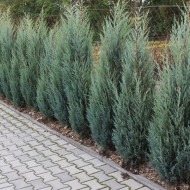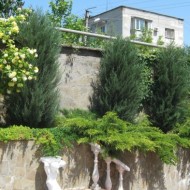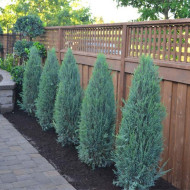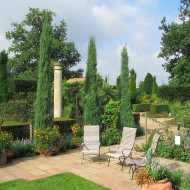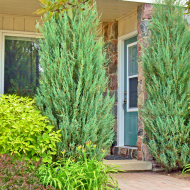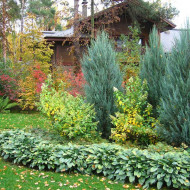How to plant and grow rocky juniper in a summer cottage
Content
General description of juniper
Despite the exotic look, the plant takes root well in the difficult climatic conditions of Russia - the life span can reach 1,000 years. Thanks to its powerful root system, the juniper successfully extracts everything it needs from the soil. For example, the Fisht rock has chosen the slopes of the Rocky Mountains in America, where its thickets are found at an altitude of 2 km above sea level.
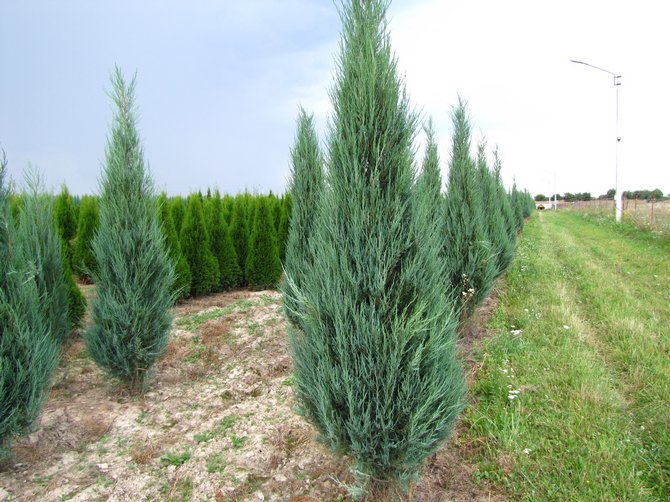
In the wild, about 70 species of coniferous mountain plants grow, while only 15 have been cultivated. Tall wild varieties stretch for 10-18 m, trunk girth reaches 1-2 m. Garden representatives are much smaller in size.
Here's a general description:
- The crown of the plant starts from the ground itself. At first, it is conical, over time it becomes rounder.
- The bark is brown.
- Young stems are light blue or greenish blue.
- Needles - leaf-shaped plates, tightly adjacent to each other, like fish scales.
- It bears fruit in the form of bluish cones with a diameter of 4–6 mm. A pair of seeds is formed inside, fully ripening by the second year.
Rocky juniper varieties
The breeders managed to diversify the family, as a result, there are options for shoes to choose from:
- tall and miniature;
- with a compact crown and spreading;
- upright and creeping;
- shrubby and in the form of trees.
Diversity is also present in the colors of existing cultures - there are all sorts of shades of green, up to gray. Juniper differs from other representatives of conifers by its ability to change color depending on the season. Having a green crown in summer, some varieties turn bronze or brown in autumn.
Ivory Arrow
Has a pyramidal crown. The needles are soft, bright blue. It tolerates severe winters typical for central Russia. The variety is undemanding to care for.
Blue Haven
Shrub-type plant, grows up to 2–5 m. The trunk diameter is 1.5–2 m. Pyramidal crown, constant color, light blue. Usually planted in a row, forming a hedge or shrub alley. Frost-resistant, not afraid of strong winds.
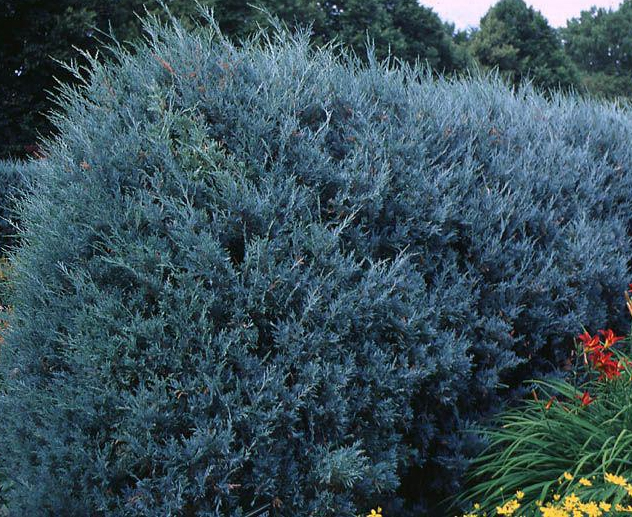
Blue Arrow
One of the most famous in our country. It takes root on any soil. Has a narrow, columnar, gray-blue crown. The twigs are pressed tightly to the trunk. The plant stretches 1.5–2 m, frost- and drought-resistant, but needs clean air, therefore it is not suitable for urban conditions. Distributed in central Russia - from the European border to the Urals.
Wichita Blue
At a height of no more than half a meter, but in diameter it reaches 1.5 m.Under favorable conditions, by the age of ten, you grow up to 3 m.In the bluish color of the Wichita Blue needles, there is a silvery shade. Light-loving, Wichita can withstand cold temperatures down to –34 ° C.
Moffat Blue
Tall (up to 3 m), diameter - 1 m. Moffat Blue needles are greenish-blue. The variety is frost-resistant, needs low humidity.
Munglow
Fast-growing, stretches out to 2–2.5 m, about 1 m in diameter. The crown is spreading, pyramidal, the needles are blue-silver. The needles are soft, do not prick. In winter, the color of the branches becomes more intense, richer. Undemanding to the soil, not afraid of drought and winds.
Silver King
Stunted (up to 0.6 m), but wide - the diameter of the crown reaches 2 m. Scaly needles are blue.
Skyrocket
The branches are compact, pressed against the trunk, directed upwards. The needles are gray-blue-green. It grows up to 3–6 m. The best growing conditions are in the southern regions, where there is little rainfall that can damage the appearance. Sun-loving variety, tolerates domestic winters normally, is not afraid of polluted air. It takes root on sandy and rocky soils. This variety is more susceptible to fungal infections than others.
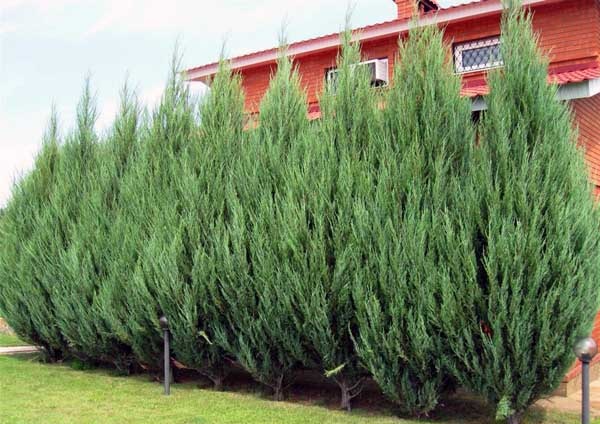
Springbank
Has a crown in the form of scattered branches, similar to a shaggy column. Stretches up to 4 m. The needles are blue-silver, thin, soft.
Video "Rocky juniper in the garden"
In this video, experts talk about the peculiarities of growing coniferous crops.
Planting rocky juniper
More often than others, specimens with a closed root system are planted. The entire warm season is suitable for planting from mid-spring to the first autumn month. First of all, they choose the right place. The requirements are as follows:
- good illumination - the juniper does not like shade (except for Chinese varieties) and, with a lack of light, quickly loses its decorative appearance;
- a small amount of moisture (groundwater must lie deep);
- fertile soil - for massive varieties, while dwarf species are harmed by an excess of nutrient components, changing their appearance;
- wind protection for some species;
- plenty of room to grow.
Any soil is suitable for cultivation, even stony and sandy, but not swampy and acidic.
To plant a seedling, dig a hole twice the size of the root system. When planting several copies, they maintain a certain distance:
- dwarf species: a step of 0.5 m;
- massive: 2-3 m.
Certain varieties require drainage, for which the bottom of the pit is laid out with a layer of small pebbles, crushed stone.
The established seedling is buried, making sure that the root collar protrudes slightly above the ground. After planting, the soil is watered abundantly, then covered with peat or sawdust. The height of the mulch layer is 6–8 cm.
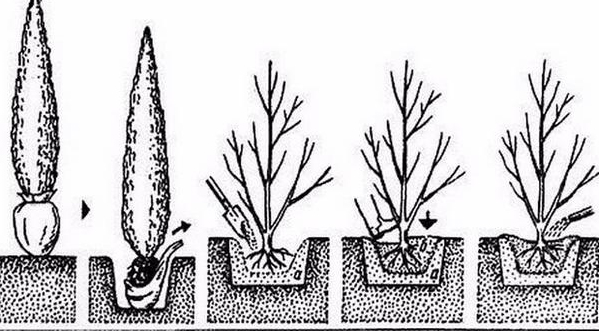
Coniferous plant care
Gardeners like rocky juniper due to its unpretentiousness. A tree or bush grows well on its own, without difficult maintenance.
Watering, feeding and pruning
The culture has enough moisture and minerals, which can be extracted from the soil with the help of strong roots. Watering is desirable only in the first year of planting and during a long drought. An adult crop, even in a drought, is watered no more than 3 times per season. In the evenings, it is permissible to spray the crown with warm water. Top dressing is not required. It is allowed to apply nitrogen and complex fertilizers in small doses 2 times a season.
A haircut should be done in order to give the crown the desired shape. Thanks to her, the juniper gradually turns into an original element of the landscape. Dry branches are cut in any case.
In the near-trunk circle, the earth is loosened from time to time, mainly after watering or heavy rainfall. Weeds are removed.

Reproduction and transplantation methods
They are engaged in transplanting in the spring, until the buds have blossomed on the plant. During this period, the maximum root formation takes place.In the summer, it is better not to do this, since the needles evaporate a lot of moisture, leading to the weakening of the plant. As a result, adaptation to a new location will take longer.
2 methods are suitable for reproduction:
- Cuttings or young layering. The upper, partially lignified shoots are chosen. They are cut off, capturing older areas of wood. The method is suitable for creeping species. Apply it during the growing season. The stripped shoots are rooted in the soil, securing with hairpins. Rooting will be completed in 0.5–1 years.
- Vaccination (for especially valuable breeds). The method is complicated, therefore it can only be used by experienced specialists.
Wintering features
Although most varieties of the crop are resistant to cold weather, it is recommended to cover the plant for the winter with spruce branches and other similar material for the first couple of years. Later, having got stronger, he will not be afraid of frosts. The abundance of snow harms the branches of dwarf varieties. Experienced gardeners advise tying the plant in the fall, pressing the shoots to the trunk.
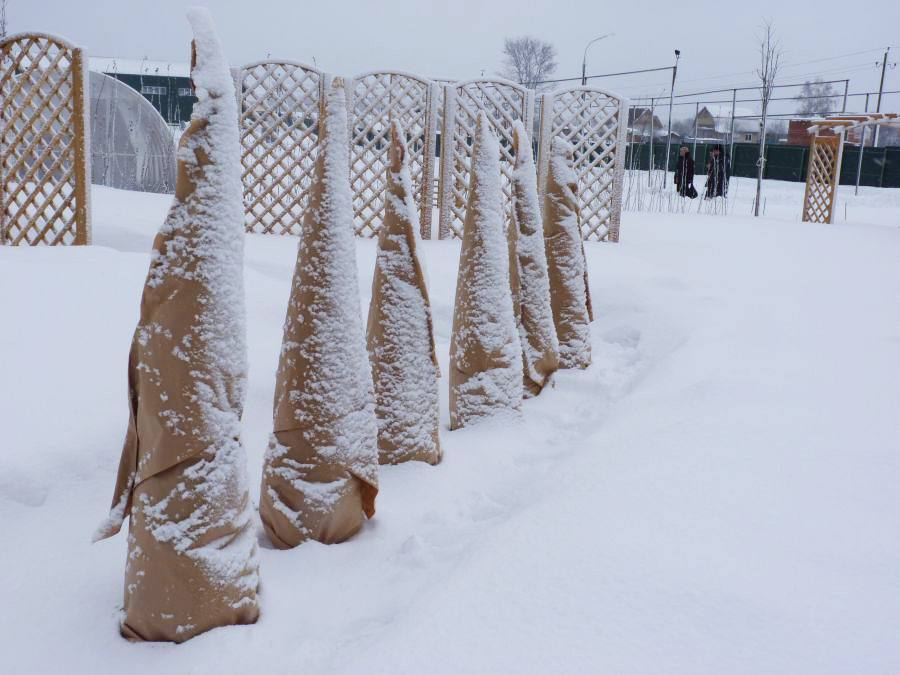
Diseases and pests
There are a number of cultural ailments. If they are identified in time, treatment quickly helps to return to normal:
- Rust - reddish growths appear on the shoots, filled with an oily substance. As a result, the culture begins to dry out and dies. Treatment involves the removal of damaged branches (they need to be burned), then treatment of the plant with fungicides: "Bayleton", "Skor" and analogues.
- Fusarium wilting occurs when there is an excess of moisture. The affected branches are cut off, then the entire trunk, branches and the ground under it are sprayed with fungicides: "Quadris", "Fitosporin-M".
- Drying of branches - the needles turn yellow, the bark is covered with fungi. For treatment, diseased branches are cut off, sprayed with "Tilt", "Ridomil Gold MC" or "Skor".
- Brown shute - the needles turn yellow and fall off. The reason is too much moisture or lack of sunlight. For treatment, sanitary pruning, spraying with "Quadris", "Skor" or "Strobi" is used. The affected branches are removed.
Of insect pests for a plant are dangerous:
- miner mole - “Decis” solution is used for treatment;
- scale - eliminated by "Karbofos" and similar acaricides;
- aphid - treatment with Fitoverm helps;
- spider mite - the same medicines are relevant as against the scabbard.
Rocky juniper in landscape design
The advantages of the plant, which determine its widespread use in design:
- variety of shapes, sizes and colors;
- a variety of coniferous texture;
- unpretentiousness;
- unhurried growth;
- minimum requirements for a haircut.
First of all, they strive to imitate the natural landscape by planting certain species on open lawns. A couple of mossy boulders are often placed nearby. Another option is to decorate a Japanese garden or alpine slide. Tall varieties are in good harmony with low-growing crops. Another common use is group planting in parks to create hedges or decorate alleys.
- Decoration of garden paths
- Wall decoration
- Hedge
- Recreation area decoration
- Entrance group decoration
- Composite fit
Rocky juniper beautifully complements all landscape styles - both traditional and modern. Coniferous vegetation easily fits into the garden and park landscape, with its help it is possible to refine the miniature garden and recreation area.

